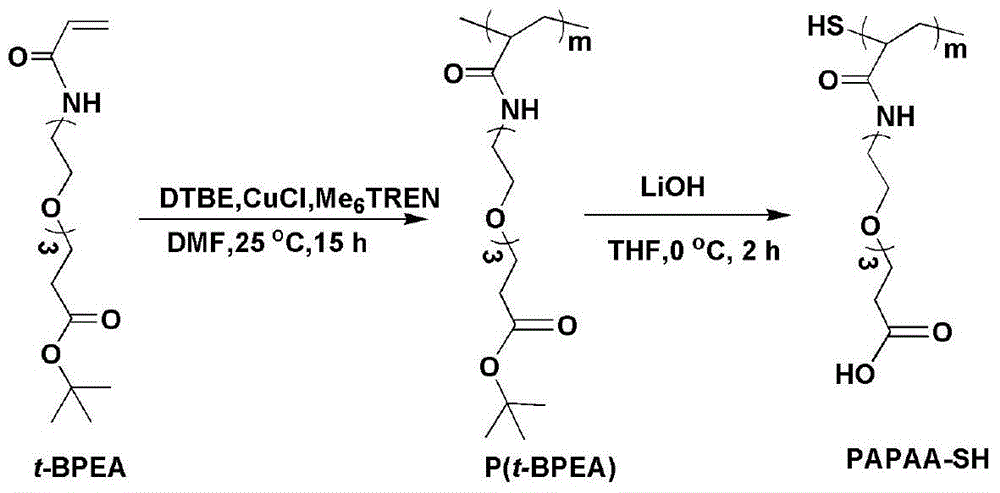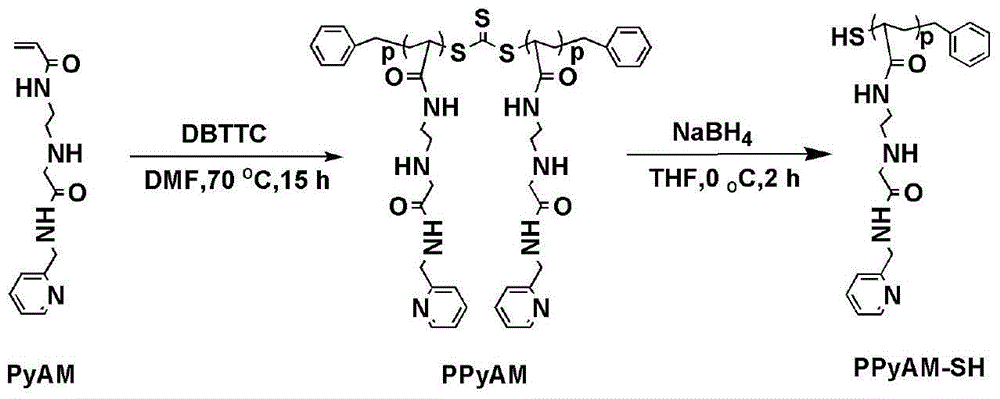Automatic classification detecting method for multiple analytes based on surface enhancement Raman scattering technology
A technology of surface-enhanced Raman and classification detection, which is applied in the field of nanometer applications and can solve problems such as interference
- Summary
- Abstract
- Description
- Claims
- Application Information
AI Technical Summary
Problems solved by technology
Method used
Image
Examples
Embodiment 1
[0071] This embodiment prepares nano-gold mixed solution probes according to the following steps:
[0072] 1. Preparation of three kinds of hydrophilic gold nanoparticles mixed solution:
[0073] A: Take a dry anhydrous and anaerobic reaction bottle with a magnetic stirring bar, and add t-BPEA (243mg, 1mmol), DTBE (4.5mg, 0.01mmol) and 4mL DMF prepared in advance to 10mL under nitrogen protection In the reaction flask, degassed with nitrogen for 30min, then added CuCl (0.99mg, 0.01mmol) and Me6TREN (2.3mg, 0.01mmol) to the reaction solution, degassed the mixture with nitrogen for 5min, then stirred the reaction at 25°C Stop at 15h, add 1mL ether to quench, precipitate the polymer, centrifuge at 5000r / min for 10 minutes to obtain a solid product, wash with 4mL ether three times, and vacuum dry until the mass remains constant to obtain P(t-BPEA).
[0074] Take a single-port reaction flask with a magnetic stirrer, dissolve 20mg of P(t-BPEA) in 5mL of THF, slowly add 2mg of LiOH ...
Embodiment 2
[0084] Determine Pb as follows 2+ 、Ag + and / or Cu 2+ The positions of the corresponding characteristic Raman scattering peaks:
[0085] Prepare a, b, c, d four parts of 2mL 50nmol / L nano-gold mixed solution probes according to the method of Example 1, wherein a does not contain other metal ions, and b contains 350nM Pb 2+ , c contains 350nM Pb 2+ and 400nM Ag + , d contains 350nM Pb 2+ , 400nM Ag + and 250nM Cu 2+ , carry out Raman scattering spectrum detection to 4 samples respectively, obtain the Raman scattering spectrum of each sample, the result is as follows Figure 8 Shown, where the curves a, b, c, d correspond to a, b, c, d4 samples respectively.
[0086] Cross-contrast the Raman scattering spectra of the 4 samples to determine the Pb 2+ 、Ag + and Cu 2+ The corresponding characteristic Raman scattering peaks can be seen at 1615cm -1 for the detection of Pb 2+ The characteristic Raman scattering peak, 365cm -1 to detect Ag + The characteristic Raman scat...
Embodiment 3
[0089] Plot Pb separately 2+ 、Ag + and Cu 2+ The standard relationship curve between the concentration and the peak value of the characteristic Raman scattering peak:
[0090] (1) Draw Pb 2+ The standard relationship curve between the concentration and the peak value of the characteristic Raman scattering peak:
[0091] Adding Pb to the 50nmol / L nano-gold mixed solution probe 2+ , to prepare Pb 2+ Samples with concentrations of 0nM, 100nM, 200nM, 250nM, 300nM, 350nM, 400nM, 450nM, 500nM, 550nM, 600nM and 700nM;
[0092] Perform Raman scattering spectrum detection on each sample to obtain the Raman scattering spectrum of each sample, such as Figure 9 As shown, it is determined from the figure that each sample is at 1615cm -1 The peak of the characteristic Raman scattering peak at ; then with Pb 2+ The concentration is the abscissa, and the sample is at 1615cm -1 The peak of the characteristic Raman scattering peak at is the ordinate, plotting Pb 2+ The standard relat...
PUM
| Property | Measurement | Unit |
|---|---|---|
| molecular weight distribution | aaaaa | aaaaa |
| molecular weight distribution | aaaaa | aaaaa |
| molecular weight distribution | aaaaa | aaaaa |
Abstract
Description
Claims
Application Information
 Login to View More
Login to View More - R&D Engineer
- R&D Manager
- IP Professional
- Industry Leading Data Capabilities
- Powerful AI technology
- Patent DNA Extraction
Browse by: Latest US Patents, China's latest patents, Technical Efficacy Thesaurus, Application Domain, Technology Topic, Popular Technical Reports.
© 2024 PatSnap. All rights reserved.Legal|Privacy policy|Modern Slavery Act Transparency Statement|Sitemap|About US| Contact US: help@patsnap.com










